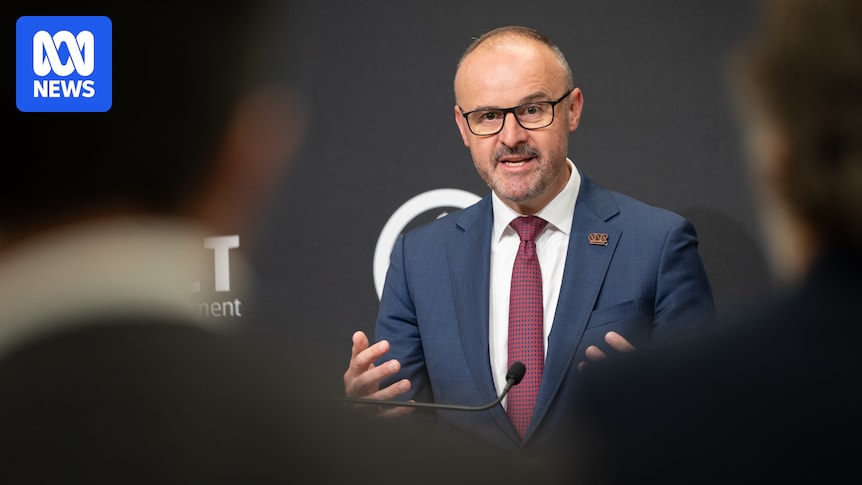With just one day to go until the ACT election, just over half of the policies submitted by the three biggest parties have been able to be costed by Treasury.
The leaders have faced questions this week over whether they should have submitted their policies to the directorate earlier to avoid such a situation.
The parties were able to submit their policies for costing to the ACT Treasury Directorate from September 12, with the directorate telling them it might not be practical to submit any after October 11, but that they would accept them up to the 18th.
As of Thursday night, the Canberra Liberals began submitting their policies for costing on October 8, and of the 99 policies they have now submitted, 55 have been costed, with Treasury saying they didn’t have enough information to cost another two.
ACT Labor submitted its first on September 25, and has had 47 of its 100 policies costed.
The ACT Greens have had half of their 14 submitted policies costed by Treasury.
Elizabeth Lee said her party has submitted all their election commitments for costing. (ABC News: Donal Sheil)
‘I don’t control Treasury’s timeline’
Canberra Liberals leader Elizabeth Lee said her party had followed the timeline allocated by Treasury.
“There is a process to get election commitments costed, and unlike ACT Labor, we’ve actually submitted all of them,” Ms Lee said.
“I don’t control Treasury’s timeline.
“We have followed the process, and we’ve submitted those policies. I’m sure that they’re very, very busy at the moment in trying to cost all of the policies from all the parties.”
Ms Lee made the comments during a press conference that led to a tense exchange with a journalist, and prompted her to make a rude gesture at him as she left.
Chief Minister Andrew Barr also defended his party’s timeline on submitting their policies for costing.
“Rules of the costing process are that you must have publicly announced policies before they can be submitted, so there’s necessarily a staggering of the submission of election commitments,” Mr Barr said.
“We had more than 60 in before the final week, effectively, and have had more policies submitted for costing than any other party, so we’ve taken the process seriously.”
“Of course, we also delivered a budget in June that outlined many of the first steps of many of the commitments that we’ve taken to the election.”
Greens leader Shane Rattenbury said his party does put their own costings on all their policies, and that they’ve been up-front with the community about their plans if elected.
Shane Rattenbury said the Greens have been up-front with the community about the costs of their policies.
“Well, the costings process does start relatively late in the campaign, for example our housing policy, we actually paid to have that independently costed, we released that in April, that is our singular biggest spend, we’ve had it externally verified,” Mr Rattenbury said.
“The Treasury part is an important verification, but we’ve made no bones about both our level of ambition and our expectations of what some of these ideas would cost.
“We’ve been up-front with the community about that and I think they’ll have a pretty good sense of where we’re going.”
What do the costings show?
So far Treasury has costed 47 Labor policies, with a total price tag of $262 million over four years.
It includes $82 million to expand the bus fleet, and $30 million to provide free meals in another 15 schools.
Mr Barr has said he believed his party’s policy offerings were fiscally sustainable.
“We’ve been very conscious that we can’t over promise in this campaign, that’s a discipline that’s been absent from the two other parties that sit in the Assembly who have made bigger spending commitments than Labor.”
The Canberra Liberals’ 55 policies costed so far amount to $513 million out of the budget.
The biggest item is $109 million to improve suburb maintenance alongside $51 million for new and better footpaths and $48 million in lost revenue, due to the cut to payroll tax.
Treasury has estimated the cost of detailed design and planning on a new stadium in the city to be around $85 million, equivalent to roughly 10 per cent of the total build cost.
But it said there were “a range of uncertainties” in that figure which needed further analysis.
The opposition has previously estimated the build cost based on similar, recently-built stadiums, including at Parramatta in western Sydney.
A proposal to build a 30,000 seat stadium at Acton has been one of the Canberra Liberals’ signature policies heading into the election. (Supplied: Canberra Liberals)
Canberra Liberals leader Elizabeth Lee said her party had shown they would be able to bring in more revenue to account for the spending commitments they had made.
“The Canberra Liberals have been very transparent and very up-front with the community about our plan, which will see us bring in more revenue, and that is a conservative estimate, to be able to deliver much needed relief that Canberrans need during this cost of living crisis,” Ms Lee said.
The ACT Greens’ seven policies costed so far have already out-priced Labor’s costs, with just shy of $282 million set to be spent out of the budget.
That includes nearly $88 million for free and universal early education for children, $62 million for a caring for waterways and catchments package and $35 million to try and get more electric vehicles into the ACT.
